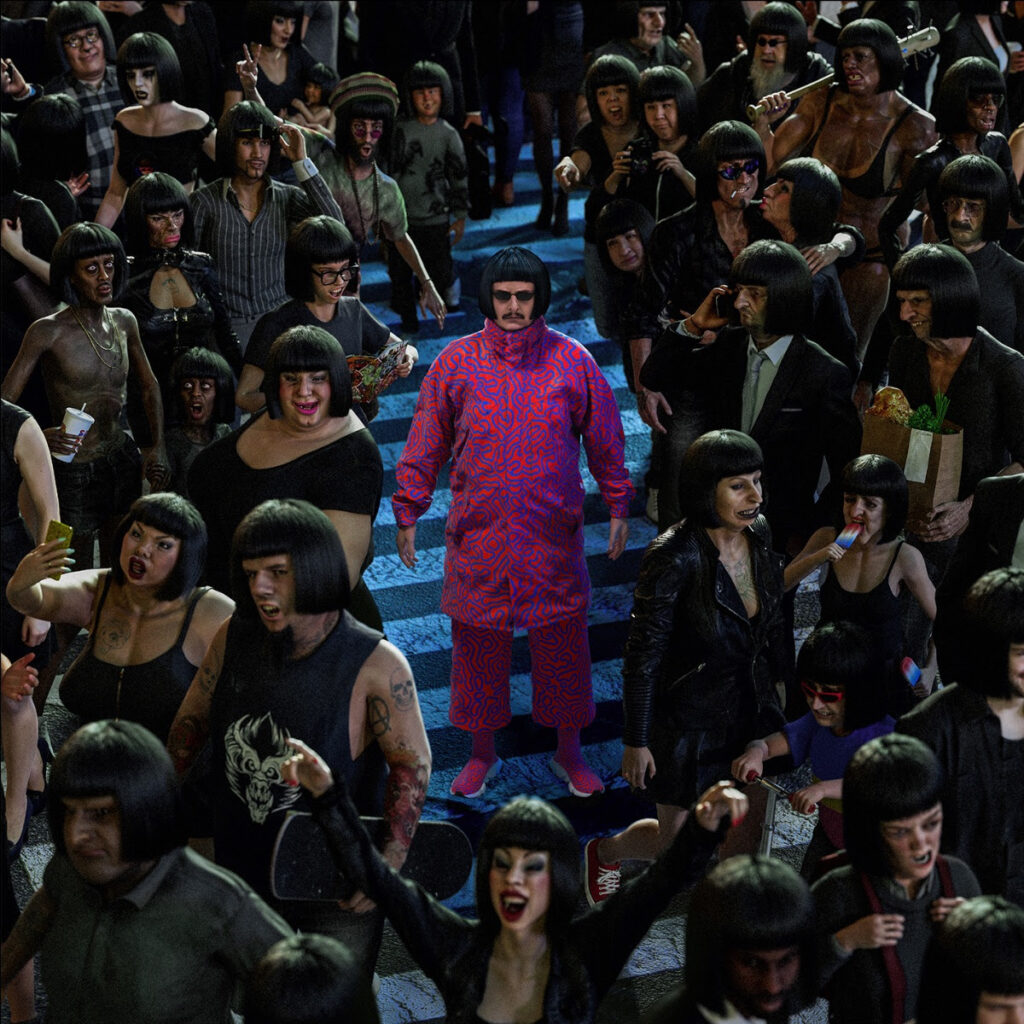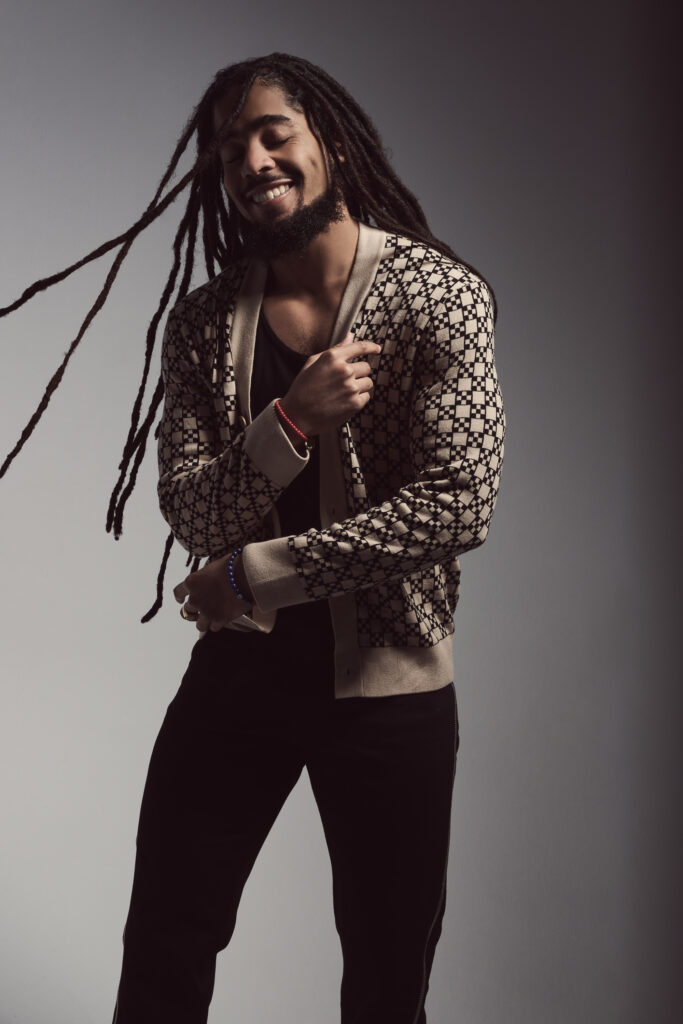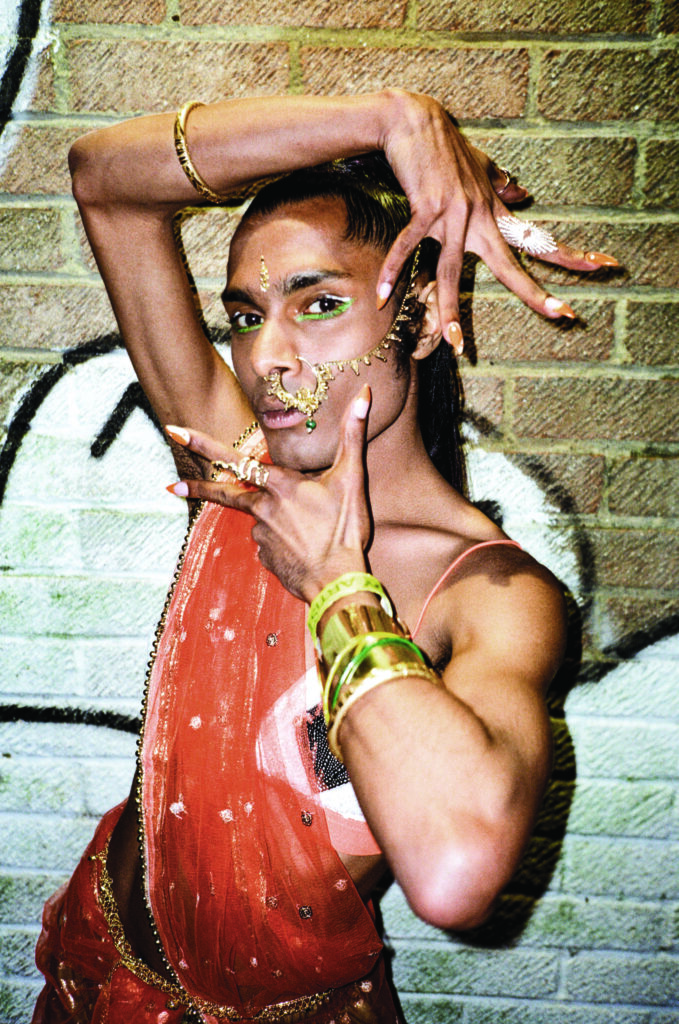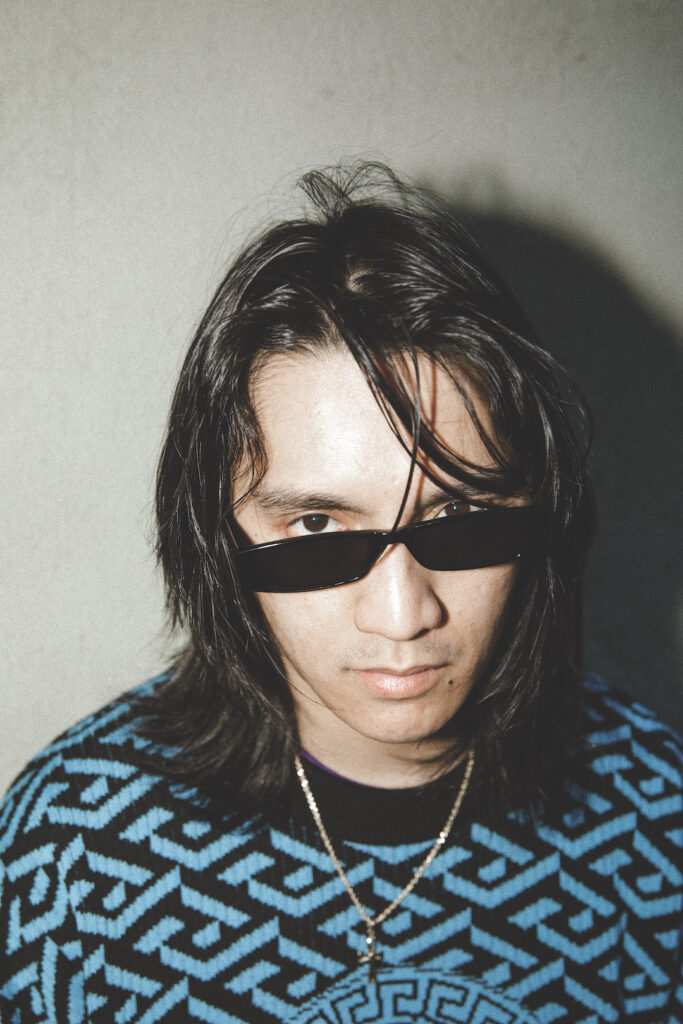California Graffiti Legend RISK Talks Art, Upcoming Projects and His Life In Constant Motion
Words by Roger Gastman
Photography by Niall O’Brien
Simply stated, RISK (sometimes RISKY) is a graffiti legend. The California artist also known as Kelly Graval is well-known for pushing art forms to their limits. He sculpts, paints, designs clothing and much more from his art HQ of sorts north of LA. Part workshop, part studio, part garage, and part gig space, Risk is dedicated to creating things 24/7 in his compound. We tapped the author of The History of American Graffiti (and our Art Editor) Roger Gastman, to ask all the right questions about what RISK is doing out of lockdown.
Roger Gastman: I’ve heard you were named after a bar. To me, that’s just such a ridiculous wild introduction to you.
RISK: My grandma’s name was Katherine Simmons and her stripper name was Kitty Kelly. She was an original dancer.
Where is this?
I think in Chicago, but she traveled around. She was, as she calls it, “a showgirl.” She ended up in New Orleans with my grandfather who owned a strip joint. He wound up blowing somebody’s head off and got in all kinds of trouble. She ran off to work in another strip joint, left him, and wound up marrying the owner. They later retired and opened a bar/restaurant called Kelly’s because she was Kitty Kelly. I was named after that bar.
Your early memories are in New Orleans, but then it’s quickly to LA and LA is really what shapes you — the surf culture, the punk rock culture, the early hip hop culture. I mean, you are LA subcultures combined.
New Orleans was very important to me, their creativity, the style and drive of the people. But coming out to LA was a big thing. In seventh grade, I quit school. My mom was a teacher and I got in a lot of trouble. She says lets go visit my dad who lived in Lake Tahoe at the time. I landed and saw snow for the first time which was cool and then she tells me: “you like that? Good because you’re gonna live here now.” My dad was a drug dealer, “think you’re a badass?” he said. Then, he hired a teacher to take me from class to class and live with us and do all my schoolwork — everything to get me on track. Right around then, I met Christian Love who was Mike Love’s son [from The Beach Boys]. He exposed me to a lot of things, including marijuana, as well as surf culture, blonde-haired girls, bikinis, skate culture — all the California lifestyle stuff.
A year later, we moved to Manhattan Beach, and I was like, “holy shit, this is all the stuff that I’ve been hearing about from Christian 24/7.” I ran out and got a surfboard at a garage sale and started surfing. I was enthralled. A year later I moved to Palos Verdes, lived on the cliff there and surfed the best waves in California. I was a diehard surfer.
My dad had to move every six months for whatever various reasons so when we moved to LA, I hated all the surfers because I was a longboarder. I had a real rough time and was pretty much an outcast. I was in my own world and was drawing pictures — waves and shit. Some kid at school said, “what do you write?” I’m like, “I don’t write. I draw pictures.” He asked this over and over again. I almost got in a fight with him because
“motherfucker, I don’t write, I draw.” He told me about the subculture of writing. He showed me pictures of New York subways. That day I went and stole two cans of red and two cans of white spray paint, went back to my school, sat there and waited for it to be dusk. I jumped the fucking fence and did a piece. It was the worst piece you ever saw in your life.
But the next day, all these kids were just looking at it. Hundreds of kids. So I kept doing it. 40 years later I’m still doing it. My life changed then because instead of getting up for surfing at 5am, I was just getting home at 5am, from painting all night. It was a transition.
Then I started getting into the roots of graffiti. I learned about hip hop. The hip hop world on the West Coast was weird because it had punk rock kids into it. It was the melting and the merging of the worlds. Fast for- ward to running away and living in Venice on people’s couches and getting introduced to Suicidal Tendencies and that whole lifestyle, the punk rock and the beach thing. The perfect storm of California culture. That was my life.
How do you work your color filled murals? It’s a great process.
It’s layers. It’s fucking layers and layers and layers. Every building is different, every surface is different. And you have to adapt to it — they all change. I spend a lot of time in the place before I paint it and look at photos or the surroundings and get my color palette. I think I’ve been most successful with that in Miami, it just works so well there. That’s the place I experimented with it the first time. When I went there, it was not fucking well received. They were like, “get the fuck out of here.” Somebody killed somebody under the lift while I was on it. But by the time I left, all these homeless people had cleaned up the area and they thanked me for making their place beautiful. They were singing and happy. So I was like, “good fucking work”, a color-filled painting evoking emotional color, that was the mission.
Those murals derived from my experience in London painting for the Olympic [Games] with Ron English and Shepard Fairey. I got there late, and they were all in the bar. Everyone was asking me what I was going to do. I didn’t know, I told them I was going to write my name. And Ron English tells me, “I don’t know, we love Risk. We’d love to see Risk. I can look at Risk all day long. But like, you’re here, you have a platform, you have a voice, you should probably say something.”
I was so pissed. I wanted to punch him in the face, like “fuck this dude.” But I started thinking about it. I’m traveling around the world painting, I support my kids with this. I guess I have to take this seriously. Let me think about what makes me tick and makes me most happy, dissect my art and figure out a meaning. I thought about what made me the happiest. And it was the next day driving down the freeway, looking at the illegal piece I did that night. You get so pumped by that big splash of color the first time you see it in the day- light. And then you realize, sometimes you can’t read that shit. Then you realize 90% of people on the free- way definitely can’t read it but they’re all still getting excited. So I started thinking about evoking the same emotion only without letters or characters. That’s how this whole process started.
At first, I painted the back of my house like that and it was really cool. It got me thinking what the architectural lines represent. Circles are the most rudimentary form of graffiti to me. The dot bubble fill in or the cloud background. And then the horizontal and vertical lines are weights and balances of fonts. So that’s my graffiti. People are always wondering why I “didn’t put graffiti on it”—it’s right there. That’s my graffiti right there. Those rudimentary lines? That’s deconstructed graffiti. I just love doing them.
As a young graffiti artist, I was all city. I was up the most. I wanted to be bigger, better, all these things. With these murals I could go even bigger. I could do whole buildings. I want to do whole city blocks now, which I’ve done more than once. It’s a deconstructive natural progression.
One of the buildings I see pop up in feeds or articles is the huge building you painted in Canada. It’s insane. I heard the experience was crazy.
We get to Canada and the first hour we’re there, they steal everything out of my manager Brian’s car. This is in the mining town of Sudbury, Canada.
How did you even end up there? Like what’s the background?
Monster Energy wanted something big. It was on the radar so I put the feelers out there to do something and then the [annual Canadian music and art show] Up Here Festival got in touch. Kwest, who’s a friend of mine, called me and was like, “I think I got something for you, you’re the only person that can do it. It’s big. It’s got to get done in 10 days.”
I told him I could do it. When I looked at the pictures I was fine and thought I could do it no problem. When I got there I realized we had major problems. I didn’t know where to start. We had the biggest lift in North America, right? But it couldn’t reach the top of the building. We had to get strapped into a crane to get up there. I’m approved by OSHA, but we still had to take classes from what they call “the magistrate.” They told us at 4am that we had to be in this class by 7am. I was like “fuck you guys.” That’s how the whole trip started.
I go to this class, I’m falling asleep. The guy’s like, “the American’s going to fail, he’s not paying attention.” I passed with the highest score.
And then the first day we’re there, all our equipment, the whole trailer, they just took it. We were a day behind now. But we got it all again and got back on schedule. We get to the roof and they tell us we can’t go on the roof. There’s all these rules. And they have this thing that I’m not familiar with it at all. It’s like a little robot that goes around the roof and you’re tethered to it with cables. It stops if it has over 30 pounds of pressure so the idea is if you fall off, it’ll stop.
We come back in the middle of the night. It was really dumb but we were jumping from ropes, building to building. We painted the whole top of the building in the middle of night. The next day we went there and were like, “holy shit who did that?” And they go, “you didn’t do that?” They were so dumb they actually believed me. And then we were able to finish the whole building. But not before they stole our equipment again. This time they broke into the trailer. When I asked them why they left the trailer the second time they told me they figured it couldn’t happen twice. That was their logic.
Then one time this family comes by in a minivan. We’d bought every sprayer 50 miles of Sudbury. I think we went through something like 17 sprayers right? We have the last two sitting there. This minivan family is try- ing to come in, they’re being hassled and I step in like, “dude, they just want to let their kid use the Porta Potty.” They pull in, pull back out and the guys tell me, “yeah, they just took your two sprayers.”
Right in front of us.
Then, we accidentally broke the fucking lift. Sloane, one of my workers, is a character. And he runs it into the garage and bends the hydraulics on it. They asked if he had anything to say for himself, and he said “fucking Canadian steel. It’s just bad steel. If we were at home it wouldn’t have bent.” It just didn’t go well. They were really pissed off.
Wild. Like this weird fucked up time all over the world, and the art world. Art has been especially important now. Any big projects coming in the next year?
There’s so much. We had the first ever non-auction show at Julien’s Auctions in Beverly Hills. We have a show at West Chelsea Contemporary in Austin, a major show with Blek le Rat. And we’re also working on some stuff tentatively in China. We have some toys coming out with Sideshow Collectibles. I’m working on the movie Vandal – it’s coming out finally. I’m probably missing a ton of things. Covid kept me in the studio and not run- ning around and we’re just working hard. We opened the print shop, we have the digital shop and then our machine shop is full bore all here on the compound.
Sounds like you live in constant motion.
I do. It cost me my girlfriend. We split up, she could not take it and I can’t have it any other way. I have to work here to be around my kids. I have to bring my work home because I work 24/7, and I want to be around my kids as much as possible. It took its toll on my personal life. But the kids love it. I’ve created something with a fam- ily around here. Everyone here is part of a family. The imprint is crazy, I’m amazed by the amount of drinks we go through, the amount of potato chips. I feel blessed, I feel happy. I think we’re killing it. It’s just a great feeling.
And you’ve got people coming out there.
Yeah, we’ve had Dave Navarro, Taylor Hawkins — any- one you can think of from Jane’s Addiction to [Red Hot] Chili Peppers to you know, Steve Vai’s coming out, actors come out. I mean, you name it — pro golfers come out here. We’ve been compared to [Andy Warhol’s] Factory. It’s crazy working with some of these people that are so talented and have resources to do stuff I’ve dreamt about. You never know who to expect out here. It’s always someone, whether it’s a buyer, seller, artist, musician, whatever.
Any parting thoughts to share for young artists?
Don’t believe the hype, ever. I live beyond my means all the time. I’m always broke, no matter how much money I make. I don’t have a choice but to keep it real. I live and breathe this, and it just works out. I’m an artist that’ll never know completion. Like this compound’s gonna just keep going. I just want more and more and more. I want to do more. I want to experience more. I want to have a good life, you know? And I want to have fun.
@riskrock















































































































